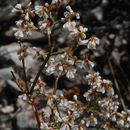Comments
provided by eFloras
Eriogonum cernuum is widely distributed, being infrequent to common or even abundant and weedy. It is common throughout most of its range in southeastern Oregon, eastern California, southern Idaho, Nevada, Utah, northern Arizona, and New Mexico. The species is rare in southeastern Washington (Franklin County). It is less common and more widely scattered in Colorado, Wyoming, and Montana, and on the northern Great Plains in southern Alberta and Saskatchewan, western South Dakota, and western Nebraska. The northern Great Basin phase, with sessile involucres, has been called var.
viminale, but this difference now appears to be ecologic rather than genetic.
Seeds of the nodding wild buckwheat were gathered by the Navajo (Diné) people, pounded into a meal, and eaten dry or made into a porridge (P. A. Vestal 1952; L. C. Wyman and S. K. Harris 1951).
- license
- cc-by-nc-sa-3.0
- copyright
- Missouri Botanical Garden, 4344 Shaw Boulevard, St. Louis, MO, 63110 USA
Description
provided by eFloras
Herbs, spreading to erect, annual, 0.5-6 dm, glabrous, grayish, greenish or reddish. Stems: caudex absent; aerial flowering stems erect, solid, not fistulose, 0.3-2 dm, glabrous. Leaves basal or sheathing up stems 2-10 cm; petiole 1-4 cm, tomentose; blade round-ovate to orbiculate, (0.5-)1-2(-2.5) × (0.5-)1-2(-2.5) cm, white- to grayish-tomentose abaxially, tomentose to floccose or glabrate and grayish or greenish adaxially, margins plane. Inflorescences cymose, open to diffuse, 5-50 × 5-40 cm; branches glabrous; bracts 3, scalelike, 1-2 × 1-2.5 mm. Peduncles spreading to ascending or deflexed to cernuous, infrequently absent, straight or curved, slender, 0.1-2.5 cm, glabrous. Involucres turbinate, (1-)1.5-2 × 1-1.5 mm, glabrous; teeth 5, erect, 0.4-0.7 mm. Flowers 1-2 mm, glabrous; perianth white to pinkish, becoming rose to red; tepals dimorphic, those of outer whorl pandurate, those of inner whorl obovate; stamens mostly exserted, 1-2 mm; filaments pilose proximally. Achenes light brown to brown, 3-gonous, 1.5-2 mm, glabrous.
- license
- cc-by-nc-sa-3.0
- copyright
- Missouri Botanical Garden, 4344 Shaw Boulevard, St. Louis, MO, 63110 USA
Distribution
provided by eFloras
Alta., Sask.; Ariz., Calif., Colo., Idaho, Mont., Nebr., Nev., N.Mex., Oreg., S.Dak., Utah, Wash., Wyo.
- license
- cc-by-nc-sa-3.0
- copyright
- Missouri Botanical Garden, 4344 Shaw Boulevard, St. Louis, MO, 63110 USA
Habitat
provided by eFloras
Sandy to gravelly or clayey flats and slopes, mixed grassland, saltbush, sagebrush, and mountain mahogany communities, oak, pinyon-juniper, and conifer woodlands; 600-3100(-3300)m.
- license
- cc-by-nc-sa-3.0
- copyright
- Missouri Botanical Garden, 4344 Shaw Boulevard, St. Louis, MO, 63110 USA
Synonym
provided by eFloras
Eriogonum cernuum var. psammophilum S. L. Welsh; E. cernuum subsp. tenue (Torrey & A. Gray) S. Stokes; E. cernuum var. tenue Torrey & A. Gray; E. cernuum var. umbraticum Eastwood; E. cernuum subsp. viminale S. Stokes; E. cernuum var. viminale (S. Stokes) Reveal
- license
- cc-by-nc-sa-3.0
- copyright
- Missouri Botanical Garden, 4344 Shaw Boulevard, St. Louis, MO, 63110 USA
Eriogonum cernuum: Brief Summary
provided by wikipedia EN
Eriogonum cernuum is a species of wild buckwheat known by the common name nodding buckwheat. It is native to much of western North America, where it grows in sandy and gravelly habitat, including woodland and sagebrush. It is an annual herb growing up to about 60 centimeters in maximum height with a thin, branching flowering stem. The rounded, woolly leaves are one or two centimeters wide and are mainly located about the base of the stem. The inflorescence is evenly lined with hanging involucres of flowers. The individual flowers are less than 2 millimeters wide and white to pink-tinged in color.
- license
- cc-by-sa-3.0
- copyright
- Wikipedia authors and editors

